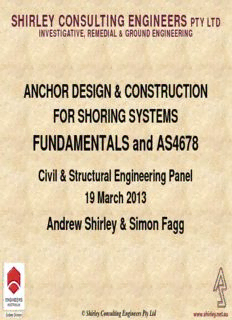
anchors for shoring systems PDF
Preview anchors for shoring systems
SHIRLEY CONSULTING ENGINEERS PTY LTD INVESTIGATIVE, REMEDIAL & GROUND ENGINEERING ANCHOR DESIGN & CONSTRUCTION FOR SHORING SYSTEMS FUNDAMENTALS and AS4678 Civil & Structural Engineering Panel 19 March 2013 Andrew Shirley & Simon Fagg © Shirley Consulting Engineers Pty Ltd www.shirley.net.au INTRODUCTION - 1 1. Soil & Ground Anchors for Shoring Systems. 2. Failures due to limited understanding & reliance on ‘expert contractors’. 3. Some engineers are simplistic in their anchor specifications, and just ‘call up the load required’. 4. Become litigation ‘targets’ when the anchor / shoring system fails. © Shirley Consulting Engineers Pty Ltd www.shirley.net.au INTRODUCTION This Presentation will cover: 1. The Fundamentals of Anchor Design for Shoring Systems. 2. The differences between soil anchors & anchors and usual reasons why anchors & shoring systems fail. 3. The requirements of AS 4678 and its implications for design engineers. 4. Five case studies of failures because the Design Fundamentals have not been followed. 5. Lessons for Design Purposes. 6. The Risks & Liability Issues for Engineers 7. A pdf version of the PowerPoint Slides will be available on our website www.shirley.net.au © Shirley Consulting Engineers Pty Ltd www.shirley.net.au EXAMPLE OF TYPICAL ANCHOR SPEC. © Shirley Consulting Engineers Pty Ltd www.shirley.net.au EXAMPLE OF TYPICAL ANCHOR SPEC. A correct understanding of the way in which the anchors interact with the structural shoring system [viz: soil / structure interaction] is essential. © Shirley Consulting Engineers Pty Ltd www.shirley.net.au ANCHORS FOR SHORING SYSTEMS 1. Anchors are NOT the same. 2. Many types of anchor; each type of anchor interacts differently with the structural part of the shoring. 3. Only limited information on the design of shoring wall anchors is generally available [e.g. CIRIA C580]. © Shirley Consulting Engineers Pty Ltd www.shirley.net.au ANCHORS FOR SHORING SYSTEMS Anchors fall into three Categories Rock Anchors Soil Anchors Dead Man Anchors • Stiff Anchorage • Deformable Anchorage • Shallow Anchorage • No load transferred from • Anchorage Zone • Surficial Failure of Dead the Rock to the Soil Interacts with the Man, typically not within Restrained Zone the Restrained Zone • No interaction between Anchorage Zone and • Where problems are • Minimal interaction Restrained Zone most frequent, and topic between of this talk Anchorage Zone and Restrained Zone © Shirley Consulting Engineers Pty Ltd www.shirley.net.au ANCHORS WITH AN ANCHORAGE IN ROCK Anchorages in rock are very common & rarely fail unless they are too short. Why? 1. Rock anchors are ‘stiff’ elements. 2. Rock Anchors form Structural Frame with the rock and structural parts. 3. Rock Anchors have a Large Overload Capacity. © Shirley Consulting Engineers Pty Ltd www.shirley.net.au SOIL ANCHORS vs ROCK ANCHORS • Anchors into rock form a ‘Frame’ • Soil Anchors do NOT create a ‘Frame’. Only a Restrained Cantilever • Soil Anchor MUST be able to ‘self tension’ © Shirley Consulting Engineers Pty Ltd www.shirley.net.au ANCHORS WITH AN ANCHORAGE IN SOIL Why do Soil Anchors Fail? 1. No Structural Frame. 2. Minimal / No Overload Capacity. 3. Incorrect Lock-Off Load. 4. Unable to ‘self tension’ if installed at too steep an angle. © Shirley Consulting Engineers Pty Ltd www.shirley.net.au
Description: